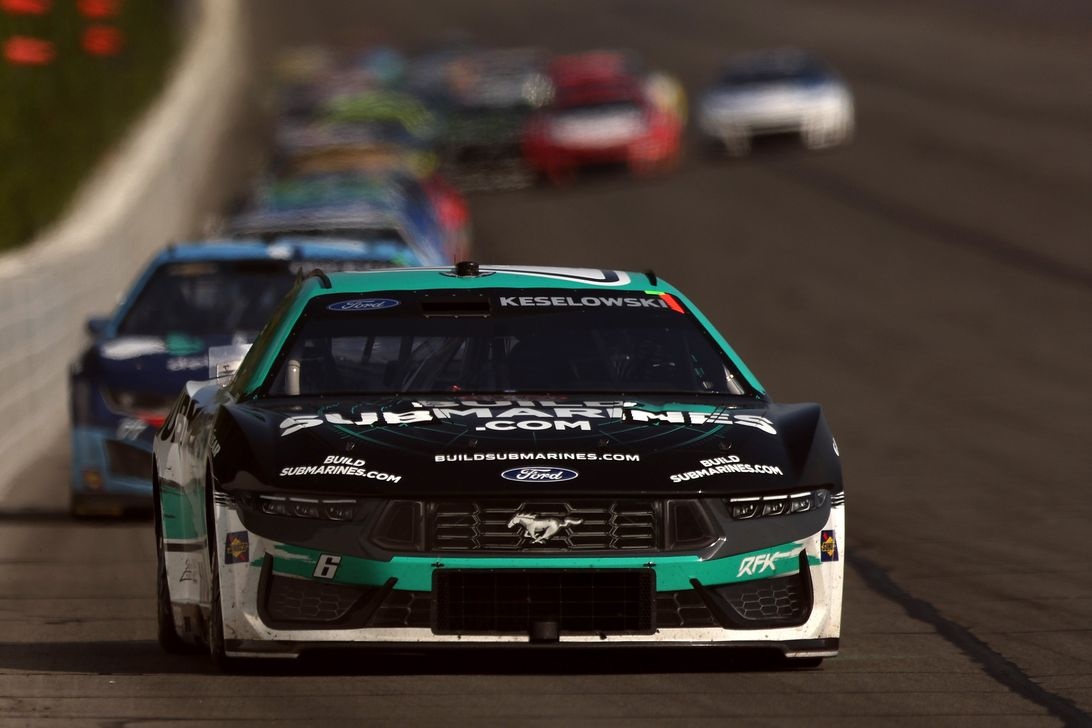Brad Keselowski’s Challenging Day at Pocono Raceway: A Close Look at the Race
Brad Keselowski, co-owner of RFK Racing, faced a rollercoaster of events during the recent race at Pocono Raceway. Known for his competitive spirit and strategic mind, Keselowski found himself at the center of a pivotal moment that could have altered the course of his race. The incident occurred on Lap 56 when he made a decision that would ultimately set him back in the standings.
The Mistake on Pit Road
During a crucial phase of the race, Keselowski was leading when he unexpectedly entered pit road. However, he was alone in this decision, as pit road was closed at the time. This misstep cost him significant track position and left his team scrambling to recover throughout the remainder of the race. Reflecting on the situation, Keselowski acknowledged the error, stating, “When we were going down the short chute, the team said pit this time and I had no reason to challenge that.” He took full responsibility, emphasizing, “Ultimately, I hold the steering wheel and I’m the one that’s gotta check, and I didn’t check the crew chief and the spotter — that’s my fault.”
The Importance of Communication
This incident highlights the critical nature of communication in high-pressure racing situations. In the fast-paced environment of NASCAR, drivers must rely on their teams for information and guidance. Keselowski’s experience serves as a reminder of the importance of double-checking decisions, especially during pivotal moments in a race.
Recovery and Strategy
Despite the setback, Keselowski’s determination shone through. He fought his way back into the race, managing to climb from the back of the pack into the top five. His performance during the race showcased both his skill and the capabilities of the Ford Mustang he was driving. After battling through the field, he found himself leading during the final cycle of green-flag pit stops—a testament to his ability to recover from adversity.
However, fortune had not fully turned in his favor. Just as his crew chief, Jeremy Bullins, called him back to pit road, Keselowski opted to stay out a few extra laps, wanting to maximize his position in clean air. This decision was soon complicated by a caution flag, which disrupted his race strategy once again.
The Role of Strategy in NASCAR
In NASCAR, strategy plays an essential role in determining race outcomes. Drivers and teams must continuously adapt to changing conditions, track position, and tire wear. Keselowski’s choice to extend his stint on the track was a calculated risk, aiming to leverage his position. Unfortunately, the timing of the caution undermined his efforts, illustrating how quickly fortunes can shift in racing.
Reflecting on the Performance
After the race, Keselowski expressed his feelings about the day’s events, noting, “We had a great car today. Our Ford Mustang was really good. We got the lead there in the first stage and felt like we were in control.” The confidence he had in his vehicle was evident, and it was clear that the team had the potential to compete for a top finish. However, the pit road penalty early in the race significantly affected their strategy and overall performance.
The Final Push
Even after the setbacks, Keselowski demonstrated resilience. On the final restart, he managed to fight back from 24th position, ultimately finishing ninth. This strong finish was not just a victory for him but also for RFK Racing, as they placed all three of their cars in the top ten. Finishing within the top ten is a noteworthy achievement, especially considering the challenges faced throughout the race.
Key Takeaways from the Race
In the aftermath of the race, Keselowski reflected on what could have been. He noted that had he pitted earlier, the caution flag would have likely come out while he was on pit road, allowing him to cycle back into a competitive position with fresh tires. He expressed regret over not capitalizing on that opportunity, stating, “If I would have pitted, the yellow would have come out while we were on pit road. We probably would have cycled inside the top ten on new tires. Might have had a shot to win the race. So, I feel bad about not taking advantage of that.”
The Learning Experience
This race serves as a learning experience for Keselowski and his team. The combination of quick decision-making and strategic foresight is essential in NASCAR. As the season progresses, these lessons will be invaluable for navigating future races and refining their approach.
Conclusion: A Competitive Spirit
Brad Keselowski’s journey at Pocono Raceway epitomizes the highs and lows of NASCAR racing. His ability to recover from a significant error and still secure a top ten finish speaks volumes about his character, skill, and the strength of the RFK Racing team. As the season unfolds, fans and fellow competitors alike will be watching closely to see how he applies the lessons learned from this race to future challenges on the track.
In summary, Keselowski’s experience at Pocono is a rich tale of resilience and strategic thinking in NASCAR. His reflections on the race emphasize the importance of teamwork and communication, while his performance showcases the competitive nature that defines the sport. Whether facing setbacks or celebrating victories, Keselowski’s journey continues to inspire fans and fellow racers alike.
